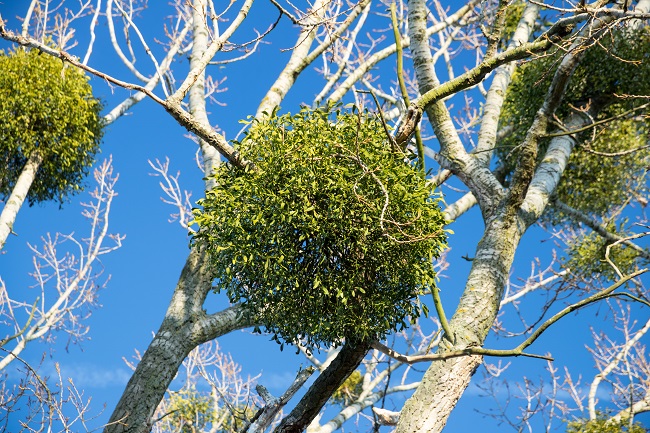Not so Friendly Mistletoe
Most people have positive, festive associations with mistletoe – if they think about it at all – but it is actually a very determined hemi parasitic plant. Its Latin name identifies it as the “thief of the tree,” referring to its parasitic growth pattern. It lives on tree branches, sinking its roots deep into the living wood and stealing nutrients from the host. This can ultimately be fatal for the unlucky tree, no matter how strong and healthy it was to start with.

Identifying mistletoe
- Check the foliage: Mistletoe grows in clumps on the branches of trees. It may look at first glance like part of the host plant, but mistletoe’s long pointed leaves and small white berries are fairly distinctive, and they won’t match the natural foliage of the host tree.
- Round growth pattern: Mistletoe clusters on a branch often form thick, rounded globes of greenery. This is especially noticeable if the tree it is growing on is otherwise bare, but it will look distinct even from the normal distributed pattern of leaf growth on most trees.
- Weakening of the tree: It is a parasite, so as it grows it steals food from the host tree. The tree may drop leaves out of season, refuse to bloom if it’s a fruiting tree, visibly droop if it’s on the smaller side, or lose whole branches.
- Common Host Trees: Mistletoe frequently targets specific tree species, with the most common hosts being cedar elms, hackberries, Bois D’Arcs, and American elms. These species often provide the ideal conditions for it to thrive. Understanding the typical hosts can help in identifying mistletoe infestations more quickly.
What to do if you suspect you have mistletoe growing on your trees
Contact Advanced Tree Care to meet with our arborists. Mistletoe has to be identified and removed completely, or it will grow back and eventually spread to other trees in your area. Infected branches must be trimmed off far enough back that the mistletoe roots are completely removed, and all new patches have to be found and cut out, no matter how small.
If you are concerned that you may have mistletoe growing on your property, please contact Advanced Tree & Shrub Care for evaluation and removal.
